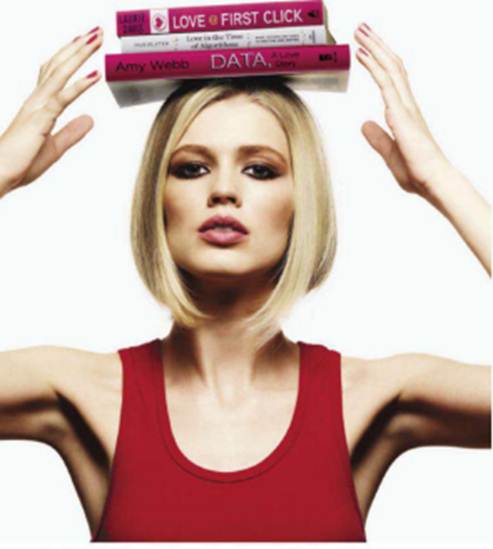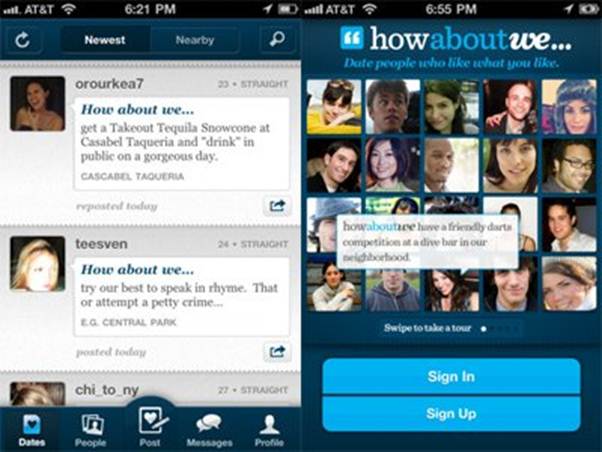Every January, Elle hits the books to suss
out the latest intelligence on how to stay ahead of the curve and on top of
your game. This month’s cheat sheet: the takeaway on sex, stress psychology,
and strategies for online dating

Mo’
Better U
Game, set, and cyber-match
How to seal the deal instead of staying on
the hook for monthly fees: three new guides ot online dating, five tactical
tips for all womankind.
At 30, after a breakup that involved
spotting her boyfriend draped around another woman, digital strategist Amy Webb
decided to try meeting men online. And she did: On JDate, Match.com, and
eHairmony, she met guys who were six inches shorter or 30 pounds heavier than
advertised; who picked expensive restaurants and passed the check to her; and
who told her, mid drink, that they were married.
One night, after another bad match and a
solo bottle of wine, Webb rejoined JDate – this time posing as a man, to check
out her competition. Then she took it further. Webb crafted 10 male profiles so
perfect they had to be fake (sample code name: JewishDoc1000) to gather data:
what the site’s most popular women looked like, which keywords they used, how
they timed their messages.

Online
dating is now the third most common way couples meet, with 30 to 40 percent of
singletons logging in to some 1,500 services.
“It seemed strange now, that I’d just slap
together my online dating profile, when I’d spent days agonizing over my
resume, tweaking and massaging it to land the perfect job”, Webb writes in
Data, A Love Story (Duffon), one of three new books about online dating out
this month, in which she recounts how she cracked the online dating code to
meet her now husband. “Yet here I was, husband hunting and armed with only a
handful of half-asses bullet points”.
Online dating is now the third most common
way couples meet, with 30 to 40 percent of singletons logging in to some 1,500
services. In the marvelously titled Love in the Time of Algorithms (Current),
writer Dan Slater tracks a phenomenon that started in 1965 with “computer
dating” essentially a digital compatibility tests, dreamed up by two lovelorn
Harvard undergrads desperate to meet Radcliffe girls 0 and mushroomed into an
estimated $2 billion a year industry.
According to Slater, it’s one of the few
business models in which clients’ failures are the company’s win – the longer
we seek, the more money they make. Aiming to short-circuit this cycle, “e-flirt
expert” Laurie Davis’ hypeprescriptive Love @ First Click (Atria) instructs us
in a level of detail that us by turns grating and illuminating on how we should
be “making our singledom”. Here, the authors’ best advice on joining – and
enjoying – the mixer:
1. Play the field
“It’s important to be in more than one
community”, Davis says. “It’s like being in more than one social circle”. She
suggests joining one mainstream site (say, eHarmony or Match.com) as well as
one niche service, such as Cupidtino, which brings Apple-product obsessives
together, or the unapologetically elitist Sparkology (the site’s men – but not
is women! – must have graduated from a “top institution”). “Changing sites from
time to time, and then revisiting, is the best strategy”, says Davis. That way,
you’re always the new girl.

“Changing
sites from time to time, and then revisiting, is the best strategy”. That way,
you’re always the new girl.
2. Ace your profile
“Your user name is going to inspire them to
click”, says Davis, who suggests a terminology mash-up (e.g., SportySmile).
“Never include your name or even initials”. Keep your About Me section positive
and fun, the way you’d ideally come across at a cocktail party. At first, Webb
thought that women who used opening lines such as “I’m a fun-loving girl that
enjoys…” and “I’m a laid-back girl who wants…” were dumbing down. But such
lightweight openers are disarming, approachable. “If someone said to you “I’m
uncomplicated, generally in a happy mood, and I like to do stuff’, you’d want
to hang out with him or her, right?” Webb found that the most successful
profiles were purposefully casual, under 500 words, and just detailed enough –
specific, but not to the point of alienating someone (“like” HBO dramas, but
don’t zero in on Game of Thrones). “Desperate women write too much”, she
observes. Davis cities psychological studies that say the mind can easily grasp
groups of three: “So stick to three interests, three words to describe your
ideal match, or three words to describe your ideal match, or three favorite
movies”. Webb advisers against mentioning your job, using foreign words, or
referring to yourself in the third person. And save the sarcasm: “Instead of
seeming witty and clever, those women just sounded angry”.
3. Get photo-ready
Dating service “How About We” found that
users who uploaded at least three photos received twice as many messages as
those who had just one. Upload seven, instructs Davis, who actually specifies
the order: “(1) close-up, (2) full-length, (3)close-up, (4) action shot, (5)
full-length, (6) close-up, (7) action shot”. Webb praises one sought-after woman’s
photo because “her hair and makeup didn’t look overdone, but she had definitely
spent time on both”. In a study by the University of Rochester, women wearing
red were found to be more attractive – yes, that old chestnut – and OKCupid
reports that women get the most messages when their expression is flirty and
their gaze is directed at the camera. (Men do best when looking slightly off
camera). Webb and Davis advocate flashing a shoulder or a little cleavage – and
both stress the importance of good lighting. To that end, Webb shot all of her
pictures at the fabled predusk “golden hour”.

Dating
service “How About We”
4. Choose your targets
“It’s impossible to message or date one
person at a time”, Davis writes. “At that rate, you’ll be dating online for years”.
To determine which profiles are worth your time, make a list (offline) of what
you’re looking for –one that is so specific you’d probably be embarrassed if
anyone actually read it. For her own search, Webb listed 72 qualities, ranging
widely from “Likes cities, hates suburbs” to “Mac person > PC person”. Davis
suggests eliminating qualities common to “any successful relationship, like
‘honesty’ and ‘trustworthiness’… Instead, focus on attributes that would
specifically appeal to you, such as ‘thrill seeker’.”
5. Beware of red flags
Psychologists at the University of
Wisconsin at Madison found that online daters who used fewer first-person
pronouns – presumably to avoid spelling out who they really are – were more
likely to be lying. And, according to Davis, when a man says “I hate drama”, he
means he has plenty already; “ready to move on” implies that he’s not; the
words intimacy, massages, and pleasurable all roughly translate to creep
alert!; and “I’m not sure exactly how to describe myself” is code for low
self-esteem. And if a profile seems short – like a guy is hiding something – he
probably is.
6. Make contact
Webb suggests keeping messages brief – 98
words each, ideally – and individualized to each recipient: Ask yourself, What
do I like about him? Choose three new people to e-mail a day until you have a
full roster of prospects, Davis advises, and take it off-line quickly – a date
should be set up in six or fewer e-mails. “Stop wasting time debating whether
you should wait until tomorrow or Tuesday to write back to your match”, she
counsels, “just hit Reply”.